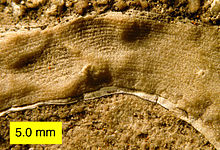- Columbus Limestone
-
Columbus Limestone
Stratigraphic range: Devonian
Etched section of hand sample of Columbus Limestone from Kelleys IslandType sedimentary Unit of Onondaga Group Sub-units Bellepoint, Marblehead, Tioga Ash Bed, Venice, Delhi, Klondike, East Liberty Underlies Delaware Formation, Ohio Shale Overlies Lucas Dolomite Thickness 0 to 105 feet[1] Lithology Primary Limestone Other sandstone Location Named for Columbus, Ohio Named by Mathur, 1859 Region Cincinnati Arch of North America Extent Ohio, Pennsylvania, Virginia, Ontario The Columbus Limestone is a mapped bedrock unit consisting primarily of fossiliferous limestone, and it occurs in Ohio, Pennsylvania, and Virginia in the United States, and in Ontario, Canada.
Contents
Description
Depositional environment
The depositional environment was most likely shallow marine.
Stratigraphy
The Columbus conformably overlies the Lucas Dolomite in northeastern Ohio, and unconformably overlies other dolomite elsewhere. It unconformably underlies the Ohio Shale in northwestern Ohio and the Delaware Limestone in eastern Ohio.[2]
Its members include: Bellepoint, Marblehead, Tioga Ash Bed, Venice, Delhi, Klondike, and East Liberty.
Notable Exposures
- The type section is located in Columbus, Ohio.
- The glacial grooves on Kelleys Island are cut into the Columbus Limestone. It is also quarried there.
- An exposure in Ontario is located at Ingersoll, Ontario.[3]
Fossils
The Columbus Limestone contains brachiopods, trilobites, bryozoans, mollusks, corals, stromatoporoids and echinoderms (including crinoids).
Due to their mid-continent depositional environment, the fossils are almost free of deformation caused by tectonic activity common in the Appalachian Mountains.
Brachiopods include Spirifer macrothyris and Brevispirifer gregarius (see Spiriferida). The gastropod (snail) Laevidentalhum martinei is present, as well as the crinoid Nucleocrinus verneulli.[4]
Fish fossils have been found in the East Liberty Member ("East Liberty bone bed").[5]
Goniatites have been found in the Columbus, including Werneroceras staufferi and Tornoceras eberlei.[6] Another cephalopod species is Goldringia cyclops.
Age
Relative age dating of the Columbus Limestone places it in the Early to Middle Devonian period.
Economic Uses
The Columbus has been mined for aggregate. Its Calcium carbonate content is 90% or higher.[7]
References
- ^ Columbus Limestone, Mineral Resources On-Line Spatial Data, United States Geologic Survey http://tin.er.usgs.gov/geology/state/sgmc-unit.php?unit=OHDc%3B0
- ^ Ohio Division of Geological Survey, 1990 (rev. 2000, 2004), Generalized Column of Bedrock Units in Ohio; Ohio Department of Natural Resources, Division of Geological Survey, 1p. http://www.dnr.state.oh.us/Portals/10/pdf/stratcol.pdf
- ^ Ehlers, G. M., and Stumm, E. C., 1951, Middle Devonian Columbus limestone near Ingersoll, Ontario, Canada, AAPG Bulletin; v. 35; no. 8; p. 1879-1888. August.
- ^ http://www.fossilprep.com/archive/articles/columbus.htm retrieved 30 Jan 2010
- ^ Wells, J.W., 1944, Middle Devonian bone beds of Ohio: Geological Society of America Bulletin, v. 55, no. 3, p. 273-302.
- ^ Sweet, W. C., and Miller, A. K., 1956, Goniatites from the Middle Devonian Columbus Limestone of Ohio, Journal of Palaeontology, vol. 30, No. 4, p 811-817. July.
- ^ GeoFacts No. 25, Ohio Department of Natural Resources, Division of Geologic Survey http://www.ohiodnr.com/portals/11/publications/pdf/geof25.pdf
Categories:- Geology of Ohio
- Devonian geologic formations
- Limestone
- Geologic formation stubs
Wikimedia Foundation. 2010.

